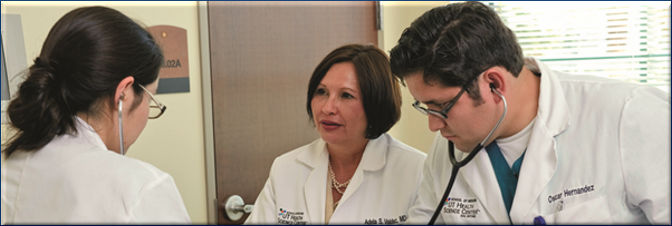By Will C. Sansom
La Prensa de San Antonio
To alleviate the shortage of physicians in South Texas, The University of Texas at San Antonio (UTSA) and the School of Medicine at The University of Texas Health Science Center San Antonio this spring accepted the first students into a seven-year Bachelor of Science (B.S.) degree in biology and Doctor of Medicine (M.D.) degree program. It traditionally takes eight years to earn both degrees.
The first 20 students in the FAME (Facilitated Acceptance to Medical Education) Program will start at UTSA this fall and are expected to graduate from the UT Health Science Center in 2020 with their medical degrees.
FAME will increase the effectiveness and relevance of predoctoral physician education while shortening its duration and decreasing its cost.
FAME inductee Brianna Bal, 18, will graduate this month from St. Anthony Catholic High School in San Antonio. Three summers of scientific preparation as a Voelcker Scholar at the UT Health Science Center helped prepare her for this new chapter. The Max and Minnie Tomerlin Voelcker Fund’s Biomedical Research Academy provides an immersive biomedical research education and college preparatory program at the Health Science Center for high school students. As a Voelcker Scholar, Bal studied a compound called rapamycin and its effects on aging.
She exhibits a determination that is characteristic of FAME students.
“The program will focus a lot of our classes on medical education, so instead of taking classes that won’t really matter for becoming a doctor, we will go to classes that are specifically designed for students coming into medical school,” Bal said. “There will even be classes that other students have not had before – blended courses with professors from UTSA and UT Health Science Center teaching together.”
She aspires to become an endocrinologist — a physician who specializes in the body’s glandular system, which controls functions such as blood sugar stabilization, bone growth and reproduction. “My goal is to practice endocrinology in the San Antonio area,” Bal said.
Statistics reflect state’s need
According to the Association of American Medical Colleges (AAMC) State Physician Data Book, Texas in 2010:
• Ranked 42nd among the states with 205 active physicians per 100,000 population. The state median, the value directly in the middle of the 50 states, was 244 per 100,000.
• Active physicians providing direct patient care (rather than serving in administration or other roles) totaled 176 per 100,000 in Texas — 46th in the country. (Median was 215.)
• Primary care physicians actively seeing patients in Texas totaled 62 per 100,000 — 48th in the country. (Median was 80.)
The FAME Program is designed to remove hurdles faced by South Texas students who, by the time of their high school graduation, have the interest and focus to enter such a program.
‘We expect these students to become trailblazers’
“We are excited to welcome the outstanding group of students in our joint program with the Health Science Center,” said George Perry, dean of the UTSA College of Sciences. “We expect these students to become the trailblazers of this new UT System initiative, which will reduce the time and expense needed to earn a medical degree, increase the effectiveness of professional training, assist in the transformation of medical education and increase the number of practicing physicians serving the South Texas region. The lessons and new curriculum we develop will be transformative for other programs at UTSA.”
“Addressing the physician shortage in Texas will take many forms and this program is an important one,” said Francisco González-Scarano, M.D., dean of the School of Medicine and vice president for medical affairs at the Health Science Center.
“This type of program has been proven at other schools to be an excellent career path. It will be a valuable option for those students who are focused on medical school as they leave high school. Furthermore, if this program is eventually expanded, shortening the time required in order to become a physician will have an important effect on the physician shortage in Texas.”
3 years at UTSA, 4 at the Health Science Center
Students will hit the books at UTSA for three years to earn the B.S. degree in biology. Courses in biology, chemistry, genetics, physiology and other subjects will include medical school preparation specifically designed for FAME students The College of Sciences and other colleges at UTSA will offer this instruction.
FAME participants will begin studies at the Health Science Center in their fourth year. Upon matriculation, pilot program participants will be integrated with the Health Science Center’s incoming medical school class. UTSA will award the students their B.S. degree in biology after they complete their fourth year in the program.
It is estimated that 75 percent of the students who enroll in the pilot B.S./M.D. program will complete it. The program will include exit points that will allow the remaining students to pursue a variety of majors or pre-health professions with little to no loss of course credits.
Principal leaders in accomplishing the B.S./M.D. seven- year program include David Henzi, Ed.D. in the School of Medicine at the Health Science Center; Hans Heidner, Ph.D., assistant chair of biology, UTSA; and Alan Vince, Ph.D., director of the Health Professions Office, UTSA.




